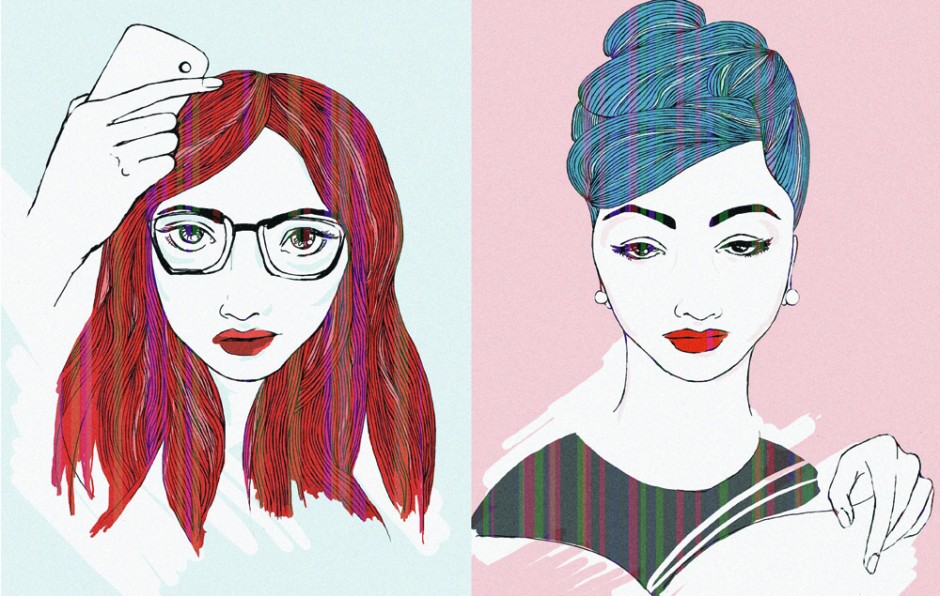If magazines were full of normal, unedited photos, would they have the same appeal? Would we still flock to the latest issues to scour over the shimmering pages and paste them to our walls? In order to create something objectively magical, inspiring, or beautiful in today’s market, we have to create something that’s better than reality.
The aim of a magazine is to inspire readers through lust-worthy images and articles that cater to their aesthetic sensibilities. The rise of social networking brought with it the ability for individuals to curate their own public image, similar to a brand, using web-based platforms to create and share their perspectives. Consequently, users can now associate themselves with creative works that they did not actually take part in creating.
“In essence, you are what you post,” says Allison McGill, editor-in-chief of Weddingbells. “It’s interesting because sometimes, a person who you have perceived to be interesting and highly creative turns out to be a disappointment on Instagram. That platform especially is all about shaping your identity, as you are allowing people to see images that reflect your world.”
Back to basics
To Paris-based photographers Hannah Dusar and Joel Benguigui, portraits reveal the essence of a person, without the shell we present to others. Favourited by web editors at Italian Vogue, and tapped as two of American Vogue’s brightest emerging photographers, their work shows that something in fashion may be shifting, with consumers seeking a realist approach in place of photoshopped perfection.
“In order to stay true to a subject, we had to give it space to breathe,” says Dusar. “We wanted to stop our preconceptions about what we thought something should look like or what we assumed someone would be like. Once we made this decision, it took huge pressure off our shoulders, because no matter what was in front of our cameras, it was never wrong or bad. The moment we decided to let life live, we started creating images that were much more real and honest. We found beauty in the flaws, emotion in the blurry shots, and a surprising amount of honesty in people’s faces because we didn’t ‘shoot’ them; we just hung out with them and made some pictures on the side,” she says.
Brooklyn-based online shopping powerhouse Gilt Groupe has become one of New York’s biggest success stories. Gilt’s senior photographer, Brandon Taelor Aviram, is well aware of the relationship between commercial and personal images.
“In order to appeal to our clients, we have to give them what they’re asking for,” he says, “not only is this true in terms of product — it also relates to image-making. The lines on what to portray are definitely blurry, and this depends on which target market you’re speaking to.”
Curating beauty
It is no secret that beauty is in the eye of the beholder — but when did we decide that curated commercial beauty was superior to our personal instincts?
Belgium’s Leonneke Derksen is now a stylist for legendary fashion house Carven, after designing for Balenciaga in Paris. In her spare time, she also designs for her own label, Leo.
Through that, she has firsthand experience with the art of selling clients the best versions of themselves. “I have creative people buying my pieces. They are buying them for the idea, the concept… just because it is beautiful. A lot of them don’t care about the idea, the brand, that stigma. They just want to feel beautiful and portray something special, something different.”
In this sense, Derksen is modelling her clients after her own way of life — one that is unapologetic in its creativity, uniqueness, and style. Her Paris apartment is stacked with layers of thick, glossy books, all topped with cheeky ceramics and elegant flowers.
In between sips of tea, she continues her train of thought: “These days, every piece needs to sell, or has to fit into a certain market. This is why more and more brands are having pre-collections… to satisfy more conventional clients. As much as we want to design without restrictions and do whatever we want… we have to always reign [ourselves] in. But always, for me as designer… it is still art. Every piece started from an idea, a reference…and ends as that piece.”
We are the editors of our own lives — we take on the role of stylist each morning when we choose what to wear, and of art director when we post images to social media. At stake is our individualism — and whether what one portrays is truly representative of who they are or an idea carefully curated by a design team.
Aviram suggests: “For me, I prefer art, or somewhere in the middle — natural and raw, but polished at the same time.”
